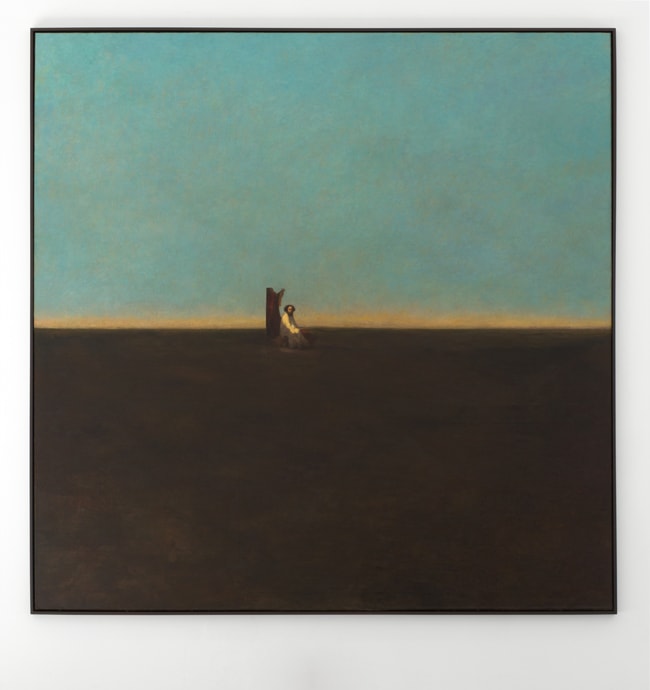
Markus Schinwald
Review: Galerie Thaddaeus Ropac, Paris, France

As if to remind us of the story so far, the exhibition opens with two of Markus Schinwald’s signature ‘enhanced’ Biedermeier portrait paintings. The Biedermeier period began in 1815, with the Congress of Vienna, but it wasn’t referred to as such until the liberal revolutions of 1848 brought it to an end: it’s an ironic title that reflects its petit-bourgeois conservatism (‘bieder’ translates as stuffy or staid). In those three decades, the middle class flourished and – especially in Austria – a slew of sentimental portrait paintings were commissioned.
For Schinwald, who lives in Vienna, original Biedermeier portraits, which are easily bought online, reflect aspects of contemporary life. (In Germany, the more conservative, well-to-do supporters of the Green Party are often described, after the name of a health drink, as ‘Bionade Biedermeier’.) Using an original painting and working closely with a skilled restorer, Schinwald adds absurd details to Biedermeier sentimentality. In the case of a diptych portrait (Untitled, 2015), the man’s head is fitted with a brass device that looks like a cross between a pince-nez, orthodontic headgear and a kind of chastity belt for the mouth, while the woman’s head appears to be stuck in a device that vaguely recalls a birdcage.
But, in the main gallery space, the scenery changes. In the centre of the gallery are eight large, white, freestanding structures. Each comprises a group of grinding brass cogs and rods, which are driven by hidden motors and force elegantly curved Biedermeier table legs to perform a series of unmistakably sexualized movements (Untitled [Maschine 1–8], 2015–16). On the surrounding walls are a series of new, large-scale paintings. To make them, Schinwald again used methods more usually employed for restoration: he isolated figures from 19th-century academic paintings and inserted them neatly into newly painted sparse architectural or landscape surroundings. For example, a back nude resting on a bench (reminiscent of Jean Auguste Dominique Ingres’s The Valpinçon Bather, 1808), sits in front of what appears to be an enormous, white theatre curtain, which fills much of the painting (Untitled # II, 2014). Similarly, in Untitled # X (2015), a solitary bearded man sitting next to a bald tree trunk, a scene that could have been pilfered from a novel by Fyodor Dostoevsky, finds himself in the middle of a bleak, brown desert. A strange glow behind him seems to suggest he might have been teleported to Mars. In Untitled #1 (2013), we catch a glimpse of a naked young man amidst an imposingly opaque facade of black and white marble, like a Spartan who has lost his way in an enormous Adolf Loos building. Especially startling is a female nude striking a statuesque pose in the manner of an allegorical figure. However, it’s an allegory that seems to have completely forgotten what it stands for: she is tucked into the lower end of a white cloth that recalls a tarpaulin covering a gigantic, soon-to-be-inaugurated monument (Untitled # VII, 2015).
Marcel Duchamp’s Pharmacy (1914) (a cheap reproduction of a winter landscape to which he added two dots of red and green) and Asger Jorn’s ‘Modifications’ from the late 1950s and early ’60s (which involved the artist defacing found canvases) are both humorous attacks on the cosy worlds of second-rate paintings and Schinwald’s obvious predecessors. Yet, Schinwald is not content with Duchamp’s game of appropriation nor Jorn’s mockery. Instead, he highlights, arguably, the suppressed longings and desires that these portraits embody, albeit only latently. As these representations from a different time are thrown into an alien environment, their bourgeois self-satisfaction is quickly replaced by a sense of narcissistic doubt and depression. You could almost believe that the paintings and sculptures are a metaphor for contemporary society, with isolated 19th-century protagonists witnessing frantic, desire-driven machinery – like a Jules Verne version of social media. From Biedermeier to contemporary Europe, perhaps we haven’t progressed as much as we would like to think.

Markus Schinwald, Untitled # X, 2015, oil on canvas, 2 × 2 m. Courtesy: the artist and Galerie Thaddeus Ropac, Paris